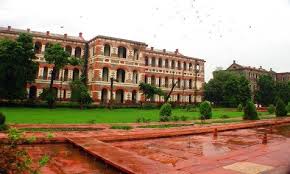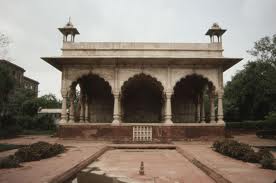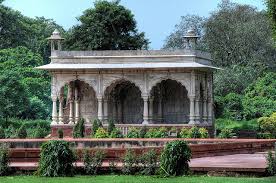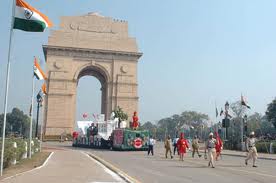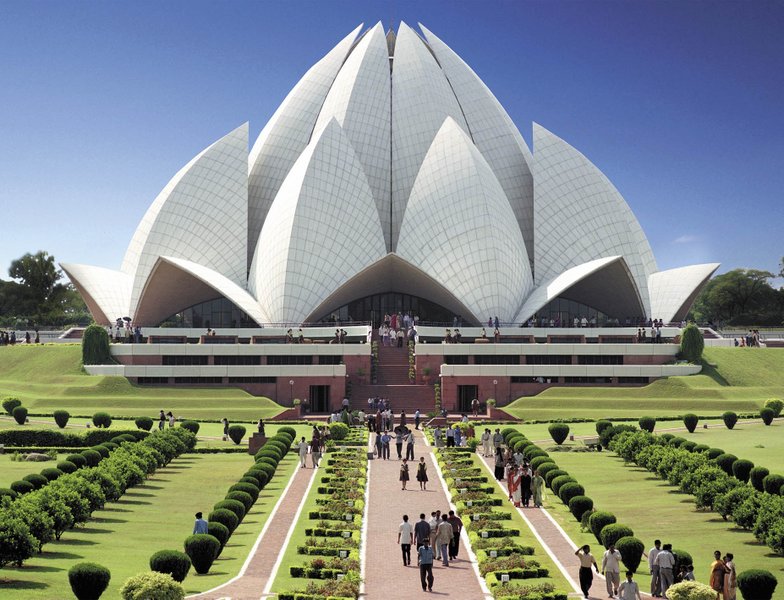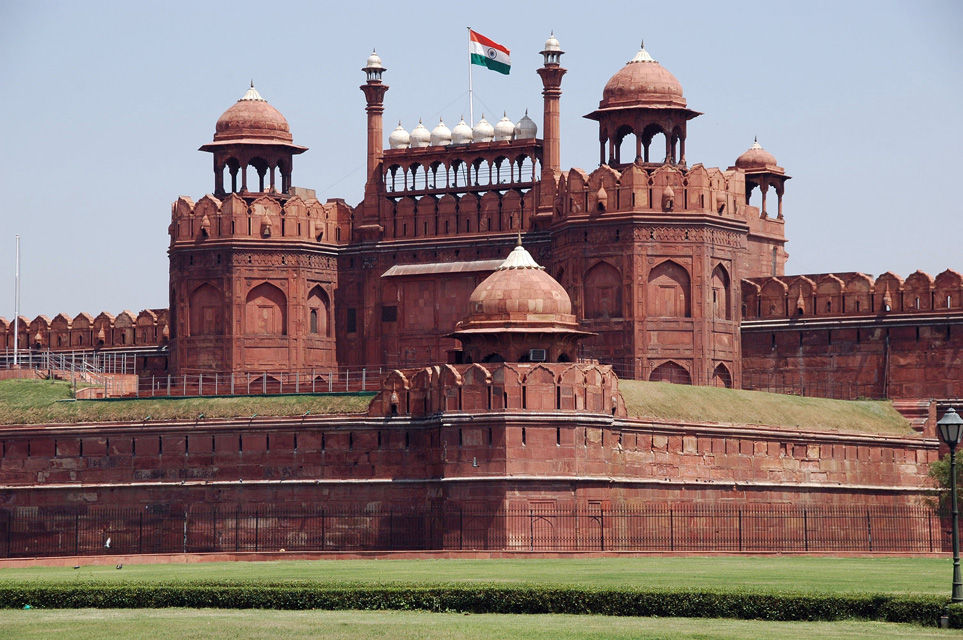Sight Address : Hayat Baksh Bagh (Life-Bestowing Gardens),Near Chandni Chauk, New Delhi Edit
Detail InformationEdit
Hayat Bakhsh Bagh is made in the typical Persian Garden Style divided into well defined squares with two water canals, a water pool and Pavilions built in the centre of both the northern and southern side named ‘Saawan’ and ‘Bhaadon’ respectively after the names of the two main monsoon months. The northern Pavilion was flanked with a gold and silver flower vase on either side. The garden actually sits at the centre of a water pool at the confluence of these two water channels with a red sandstone pavilion built at the centre by Bahadur Shah-II during the 19th Century AD and named after him as the ‘Zafar Mahal’.
HistoryEdit
Hayat-Bakhsh-bagh (‘life-bestowing garden’) is called to the area occupied by a garden north of the Moti Masjid, divided into squares on the pattern of Mughal gardens with causeways and channels between them. It finds mention in the contemporary accounts, although its present layout is new. At the north-eastern corner of the garden is a tower, called Shah-Burj, now dome less, which suffered much during the Mutiny. A similar tower known as Asad-Burj stands on the south-eastern corner of the fort. The water for feeding the Nahr-i-Bihisht was apparently lifted up to the Shah-Burj from the river and then carried by channels to the various palaces. The present pavilion adjoining the tower on the south was perhaps built during Aurangzeb’s reign. In the centre of the north wall is a marble cascade sloping into a ‘scalloped’ basin. Two other marble pavilions in the centre of the northern and southern sides of the garden are known as Sawan and Bhadon, two principal months of the rainy season, either because they represent those months or wereused during those months, but which is Sawan and which is Bhadon is not exactly certain. The northern one is provided with a tank with niches for candles in its sides, so that the water cascading over them would create a picturesque effect. On the elevated strip of land along the eastern wall stood two small marble pavilions, built by Bahadur Shah II, the northern one known as Moti-Mahal and the southern one as Hira-mahal. The former was removed after the Mutiny; the latter still stands. In the center of the garden is a large tank with a red stone pavilion in its middle, originally connected by a causeway with the garden. It is known as Zafar-Mahal, after Bahadur Shah II, by whom it was built, in about 1842.
Must SeeEdit
Popular
Visiting TimeEdit
9am-6pm
Closed OnEdit
N.A.
Best Season to VisitEdit
October to March
Best Time To VisitEdit
Morning,Afternoon & Evening
Time Required for SightseeingEdit
N.A.
Ticket Required : No Edit
Individual National Adult Rs. : N.A.
Kids Rs. : N.A.
Individual Foreigner Adult Rs. : N.A.
Kids Rs. : N.A.
Still Photo Camera Rs. : N.A.
Video Camera Rs. : N.A.
Guide Required : No Edit
Approximate cost: N.A.
Dress Code (If Any) : No Edit
Dress Require: N.A.
Restaurants NearbyAdd / Edit
- Taj Mahal Hotel ; 1, Mansingh Rd New Delhi, DL 110011 ; Ph/M – 011 2302 6162 ; Food Serve – N.A.
How to ReachEdit
Taxi : This place is well connected by road the taxi service is available for this destination. Call 40406060 to get cab at any place and to anywhere in Delhi. Price will be – Indica Vista (New) 10.00 Rs/ km, Indigo cs /Swift Dezire (New) 12 Rs/Km, Tavera (New) 13 Rs / km, Xylo (New) 13 Rs / km, Innova (New) 13 Rs / km, XUV-500 (New) 16.00 Rs/km, BMW (New) 80.00 Rs/km, Audi (New) 90.00 Rs/km,Honda City (New) 30.00 Rs/km,Tempo Traveller (New) 17.00 Rs/km, Corola (New) 30.00 Rs/km Honda-crv (New) 40.00 Rs/km, Mercedes (New) 90.00 Rs/km.
Bus : Tourists can either take local buses from various points within the city to reach this sight, which is located in North Delhi.
Train : For foreigners, it’s easiest to make ticket bookings at the helpful International Tourist Bureau 23405156; 1st floor, New Delhi train station; 8am-8pm Mon-Sat, to 2pm Sun). Do not believe anyone – including porters – who tells you it has shifted,closed or burnt down and don’t let anyone stop you from going to the 1st floor of the main building for bookings. When making reservations here, if you are paying in rupees you may have to provide back-up money exchange certificates (or ATM receipts), so take these with you just in case.
Air : International and domestic flights all leave from and arrive at the airport’s gleaming new Terminal. For flight inquiries, call the international airport (0124-3376000; www.newdelhi airport.in). At the new Terminal 3 there are 14‘nap & go’ rooms with wi-fi, a desk, TV and bed (₹315/hr).For comprehensive details of domestic air routes, see Excel’s Timetable of Air Services Within India (₹55), available at news stands When making reservations request the most direct (quickest) route. Note that airline prices fluctuate and website bookings with some carriers can be markedly cheaper.
Jagson Airlines (23721593 Vandana Bldg, 11 Tolstoy Marg)
Kingfisher Airlines (23730238; 42N-Block, Connaught Place).
Others : METRO The new high-speed metro line is the best way to get to/from the airport, and runs between New Delhi train station and Dwarka Sector 21, via Shivaji Stadium, Dhaula Kuan NH8 (Mahipalpur station) and Indira Gandhi International station (Terminal 3). Trains operate every 10 minutes from 5am to 1am. Cycle-rickshaws are still in use in parts of Old Delhi, though they have been banned in Chandni Chowk to reduce congestion. Let’s hope they’re not banned in other areas, as they’re the best way to get around Old Delhi – the drivers are wizards at weaving through the crowds. Tips are appreciated for this gruelling work.
Things to CarryEdit
Carry a bottle of drinking water.
Safety / WarningEdit
Don’t flash jewellery or large sums of money and keep daily cash in separate pockets.
HelplineEdit
Fire – 101
Ambulance – 102
Child Helpline – 1098
Women Helpline Number : 1091
Accident & Trauma Service – 1099
Police Control Room Number : 100
Tourist City Information Service – 1286
